
Welcome to the Experian Thought Leadership Hub
Gain insights into the fast-changing world of consumer and business data through our extensive library of resources.
41 resultsPage 1
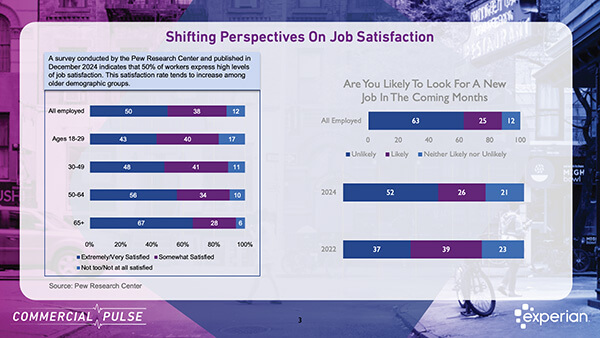 Video
Video
𝗧𝗵𝗲 𝗹𝗮𝘁𝗲𝘀𝘁 𝗘𝘅𝗽𝗲𝗿𝗶𝗮𝗻 𝗖𝗼𝗺𝗺𝗲𝗿𝗰𝗶𝗮𝗹 𝗣𝘂𝗹𝘀𝗲 𝗥𝗲𝗽𝗼𝗿𝘁 𝗶𝘀 𝗼𝘂𝘁!
While job satisfaction remains high ⭐, 𝟭 𝗶𝗻 𝟰 𝗲𝗺𝗽𝗹𝗼𝘆𝗲𝗲𝘀 𝗮𝗿𝗲 𝗰𝗼𝗻𝘀𝗶𝗱𝗲𝗿𝗶𝗻𝗴 𝗮 𝗷𝗼𝗯 𝗰𝗵𝗮𝗻𝗴𝗲 ⚠️.
Also, union membership is at a historic low—𝗷𝘂𝘀𝘁 𝟵.𝟵%—but public support is rising, especially among younger workers. These dynamics are reshaping employer-employee relationships, with big implications for small businesses.
𝗢𝘁𝗵𝗲𝗿 𝗸𝗲𝘆 𝘁𝗮𝗸𝗲𝗮𝘄𝗮𝘆𝘀:
✔️ Inflation cooled to 2.8%
✔️ 228K jobs added in March
✔️ Unemployment rose to 4.2%
✔️ Consumer sentiment dipped to its lowest since 2022
Small businesses continue to show resilience, with optimism inching up and business starts outpacing pre-pandemic levels.
Check out the full report to see how these trends could impact your strategy!
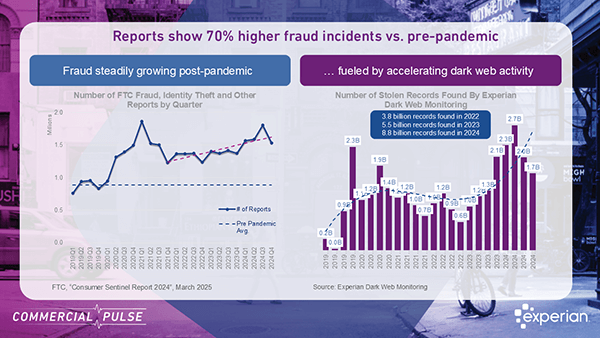 Video
Video
This week’s Commercial Pulse Report from Experian reveals critical shifts in the economy for small businesses. Inflation eased slightly to 2.8%, and the Small Business Index ticked up to 41.5—signs of stabilization. But rising financial fraud remains a major concern. Also:
🔒 70% increase in fraud since the pandemic
🧠 $40B in projected losses from AI-driven scams by 2027
📊 46% of SMB loan applications showed signs of first-party fraud
Lenders are responding with AI-powered analytics and cross-industry collaboration to stay ahead of these threats.
Check out the full report to see how these trends could impact your strategy!
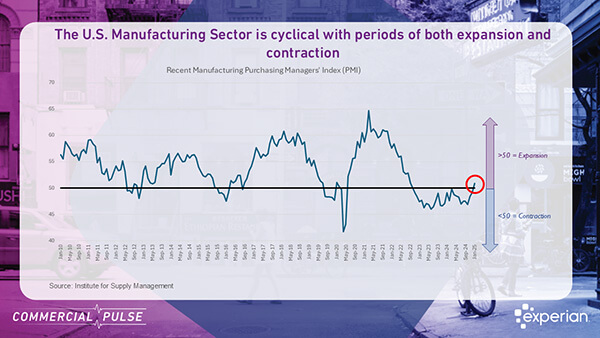 Video
Video
In this week's video we touch on current small business macroeconomic conditions as well as share insights on the manufacturing
The U.S. manufacturing sector has been in a period of contraction for more than two years, but recent data suggests that a turning point may be on the horizon. The Purchasing Managers’ Index (PMI) reached 50.9 in January, breaking past the critical 50-point threshold for the first time in 26 months. This indicates that manufacturing activity is shifting from contraction to expansion, a positive sign for small businesses that have been a major driver of growth in the sector.
Check out the full report to see how these trends could impact your strategy!
Subscribe to Commercial Pulse Report
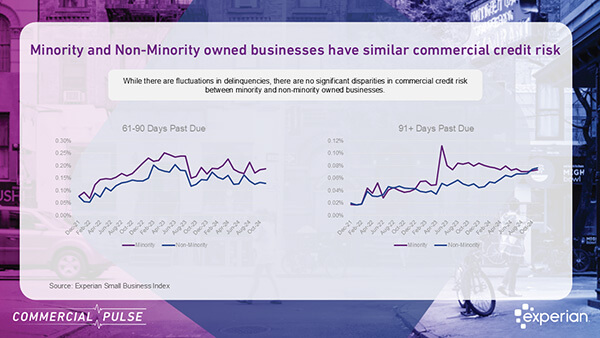 Video
Video
In this episode, we discuss the growing economic crosswinds affecting small businesses, recent employment trends, consumer spending patterns, and the impressive growth of minority-owned businesses in the U.S. We highlight the challenges and opportunities these businesses face, particularly in accessing needed capital.
📌 41% of new commercial accounts are minority-owned, yet access to capital remains a barrier.
📌 44% of minority-owned businesses are less than six years old, showing strong entrepreneurial momentum.
📌 Industries like retail, construction, and healthcare are fueling this expansion.
For lenders, this represents an untapped market and a business opportunity with high growth potential.
Check out the full report to see how these trends could impact your strategy!
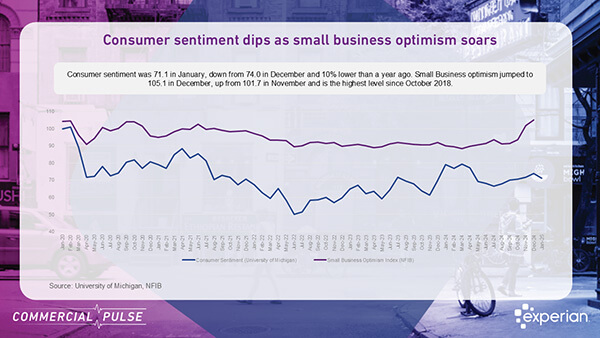 Video
Video
This week's Commercial Pulse Report highlights key economic trends and small business credit conditions, providing insights for lenders, risk professionals, and business leaders.
The U.S. economy continues to face high interest rates and shifting market conditions:
This report features the latest findings from the Experian Small Business Index™, a data-driven tool tracking small business financial health.
Check out the full report to see how these trends could impact your strategy!
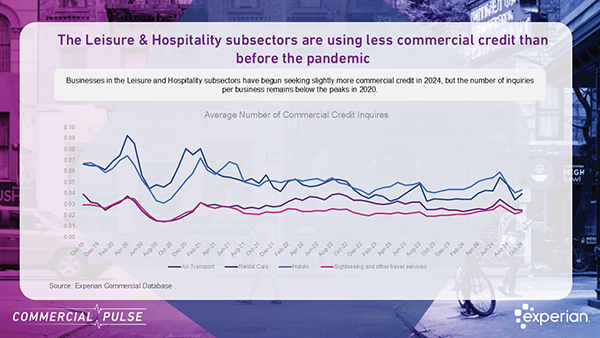 Video
Video
The latest Experian Commercial Pulse Report highlights a remarkable rebound for the Leisure & Hospitality sector:
✈️ TSA screened 903M+ passengers in 2024—a 6.5% increase over pre-pandemic levels.
🏨 Hotel occupancy rates are recovering, though still below pre-pandemic levels, as corporate travel remains reduced.
📊 Credit risk scores across subsectors are steadily improving, reflecting stabilizing financial health.
These trends showcase the sector’s resilience, supported by lower travel inflation and strong consumer demand despite economic pressures.
Credit managers, are you leveraging these insights to adjust your strategies?
Check out the full report to see how these trends could impact your strategy!
 Video
Video
As published on the Business Information blog, Experian's latest Commercial Pulse Report highlights how risk profiles vary significantly by industry and business age.
🔹 New businesses in sectors like Construction and Food Services face higher delinquency rates, signaling elevated credit risks.
🔹 Meanwhile, industries like Retail and Healthcare maintain stable performance, regardless of business maturity—offering balanced opportunities for lenders.
Understanding these dynamics is critical for tailoring lending strategies, mitigating risk, and supporting business growth across industries.
Check out the full report to see how these trends could impact your strategy!
 Webinar
Webinar
Watch the recording of the Quarterly Business Credit Review webinar, where Experian shared and discussed critical insights from the latest Main Street Report.
Visit our Commercial Insights Hub for more economic insights and reports on small business.
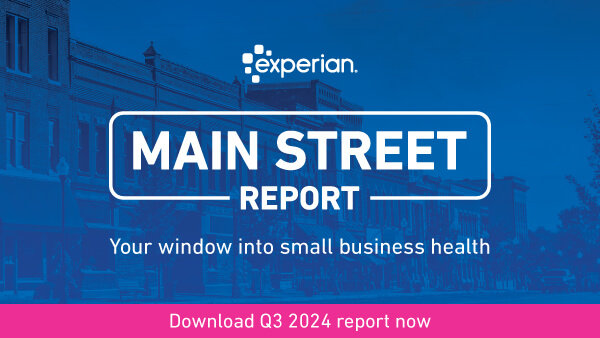 Report
Report
The U.S. (United States) has been in a state of suspended animation from a small business perspective. The domestic election cycle was full of promises focused on government spending to resolve consumer and small business perceived challenges for the next four years. As we emerge from the election cycle, with a clean transition expected, what rhetoric will become a reality is creating uncertainty among lenders and small businesses. Macroeconomic indicators are leaning positive, while stubborn inflation increases prices and borrowing costs. Lenders are targeting a looser environment for underwriting as cashflows remain positive and small businesses feel the rush of holiday shopping. Growth is coming in 2025; the question is how quickly companies can prepare and maneuver through the next 6 months of policy and global volatility.